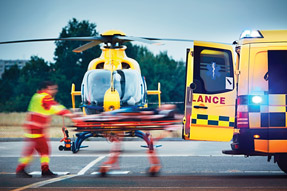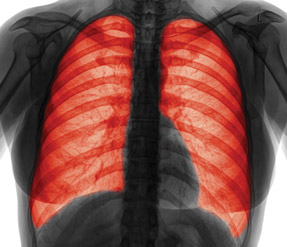Advice for physicians requesting air medical transport
When picturing air medical transport, many people think of helicopters, but there are often other options.
Patients' air transport options aren't something that clinicians typically know much about, Ryan Deedo, MD, told attendees at CHEST 2016, held in Los Angeles in October.
“Do you spend more time ordering a pizza versus how much time you spend thinking about how you're going to transfer a patient?” asked Dr. Deedo, who is an emergency and flight physician in Calgary, Canada.

Unlike a pizza order, a transport decision can have serious, long-term effects on patients' outcomes and even finances, he and fellow speaker Ashley Liebig, RN, explained during a session titled “Air Medical Transports: The Clinical and Financial Implications.”
When picturing air medical transport, most people think of helicopters, but for most patients, there are other options, including fixed-wing aircraft and ground ambulances. “You can't just send a helicopter for everything,” said Dr. Deedo. “You wouldn't say your patient needs surgery, just get a surgeon.”
As with surgeons, there is wide variation in the capability, availability, and cost of these services across the U.S., the experts said. It's particularly important that physicians who are sending or receiving patients via these transports know the capabilities of the people who will be transporting them. “In the U.S., unlike most other parts of the world, we don't have very many doctor/nurse programs,” said Ms. Liebig, who is a flight nurse and chief clinical supervisor for Travis County STAR Flight in Austin, Texas.
More often, air transport crews include a nurse and a paramedic or respiratory therapist, she said. Meanwhile, a patient requiring emergency transport may have multiple complex care requirements, including chest tubes, central lines, and a ventilator.
“We sort of assume they can bag the patient, or they can ventilate the patient. But really what level of training and experience do they have with the vent? Do they just hit silent when the alarm goes off or do they actually know how to troubleshoot it?” said Dr. Deedo.
The best way to find out the answers to these questions may be to talk to the medical director of the transport service, Ms. Liebig recommended. Ask about specific capabilities and experience of the staff, for example, whether they can use push-dose pressors. “Lots of people like to say ‘Oh, we're critical care certified.’ That might mean that someone took a course for a week and took an exam,” she said.
There are also important variations in the capability of aircraft. Helicopters come in single- and dual-engine varieties, and in most other countries, only dual-engine craft are used as air ambulances, given their greater capabilities and safety. “Right now 51% of all air ambulances in the U.S. are single engine,” said Dr. Deedo.
Other relevant factors may include the size of the patient. “My aircraft can't take anyone over 300 pounds. We've had a few times when someone's forgotten to ask,” Dr. Deedo said. “Most [air transport] places are probably going to have a dedicated bariatric team available.”
Time and speed should be taken into account in multiple ways. Helicopters may often be able to travel fastest, but if a patient has to stay below a certain altitude due to an ailment such as decompression sickness, a pressurized plane could be the speediest option, Dr. Deedo said.
The vehicle options also vary in the delay until they're ready for transport. But then, so do the patients. “Are they ready to go now, or is there a lot of stuff you need to do beforehand? Because that could change things,” said Dr. Deedo. “When you call me with a patient who needs to be intubated, needs a central line, needs a chest tube, you've got at least 45 minutes to an hour of work before the patient is ready to go out the door.”
Clinicians should also consider whether a patient will actually benefit from faster transport. “Quite often I get small hospitals calling with patients they're not comfortable intubating. Once we show up and do that, you can drive them 12 hours once you get them stabilized,” said Dr. Deedo. “I could rush them all the way there and then they could sit on the floor at my hospital for 4 hours waiting for the surgeon.”
In such cases, it might make more sense to transfer the patient more slowly, by critical care ground transportation, if it's available. On the other hand, sometimes the most effective use of scarce resources could be summoning a helicopter.
“If you use the one advanced life support ambulance in a small region to drive a patient five hours somewhere, that means that small town or that small region doesn't have any ambulance companies for close to half a day by the time they get back and get back in service,” said Dr. Deedo.
It's important to also keep in mind, though, that use of air transport can have a dramatic impact on patients' finances, according to Ms. Liebig. Air medical transport falls into a legal gap, because states regulate ground medical transport, but the 1978 law that deregulated commercial airlines prevents states from regulating the airborne type, she said.
“Recently these companies are in the news for obscene bills and collection practices. We're talking about liftoff fees in the $25,000 to $30,000 range and approximately $300 per loaded mile,” she said. “If your insurance pays a generous $15,000 of that bill, you're left with the remaining balance in the $30,000 range, and they will put a lien on your home.”
There are some efforts to impose a legislative solution to this problem, but in the meantime, physicians should pay attention to how emergency transport could affect their patients, the experts urged.
“Often the task of calling an air medical provider is tasked to the ICU charge nurse, the unit charge nurse, the unit secretary. Honestly the call goes to the person who brought the latest T-shirt or the hat or the flash drive or whatever PR or marketing material,” Ms. Liebig said. She encouraged her audience to think about these issues beforehand and have a plan in place when transport questions arise. “Just because it's infrequent or unlikely doesn't mean it's not really important. It is your problem.”





